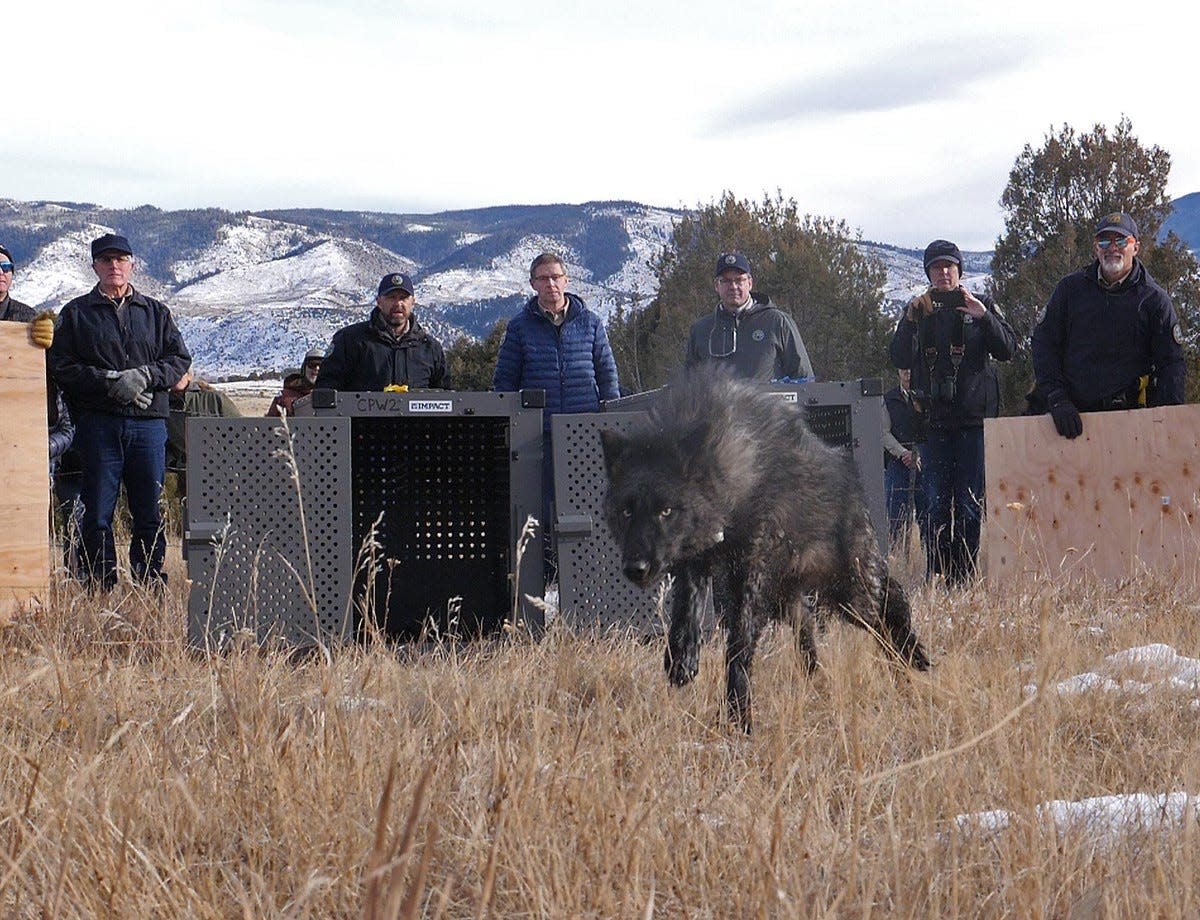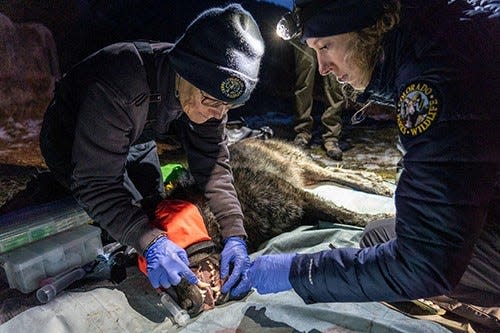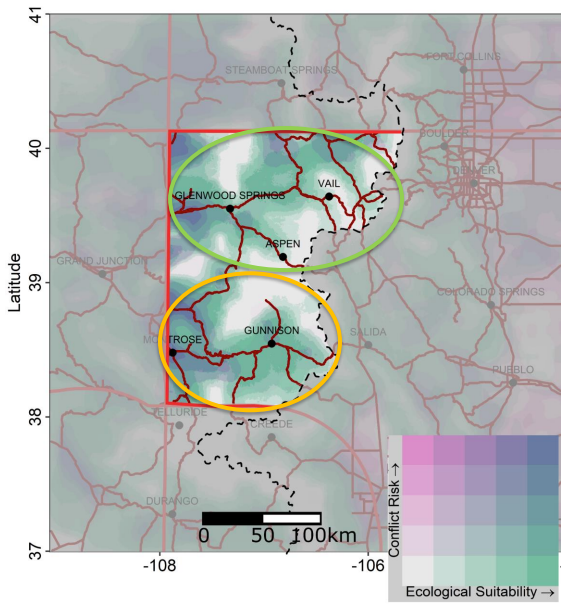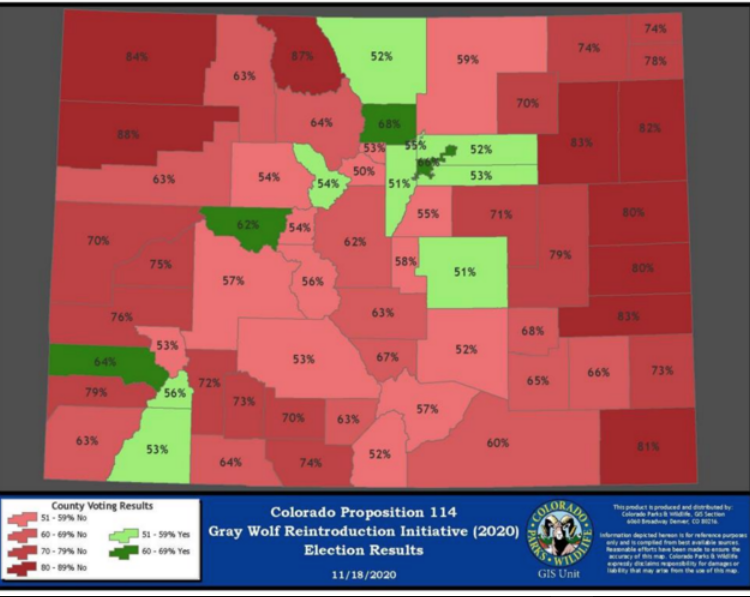Colorado releases 5 wolves as first reintroduced predators from Oregon hit the ground

Three years after Colorado voters narrowly passed a ballot initiative to reintroduce wolves, the first paws from the measure hit the ground running Monday.
Colorado Parks and Wildlife released five wolves at an undisclosed location in Grand County after they were captured in Oregon on Sunday and flown to Colorado, according to a news release from the state wildlife agency.
The wolves include two juvenile males, two juvenile females and one adult male. Three of the wolves are gray and two are black.
The wolves were fitted with GPS satellite collars and given numerical names according to their collar.
The wolves were captured via helicopter from three different packs in northeast Oregon: two from the Five Points pack, two from the Noregaard Pack and one (an adult male) from the Wenaha Pack.
The wolves, which weighed between 68 and 108 pounds, were given vaccines, placed in crates and flown to Colorado.
Oregon was the only state willing or able to provide Colorado wolves to meet this year's deadline.
The release culminates a process three years in the making. In 2020, voters narrowly approved reintroducing wolves west of the Continental Divide by the end of 2023.
Colorado Wolf Release 12-18-23 from Colorado Parks & Wildlife on Vimeo.
Colorado Parks and Wildlife will repeat the process until at least 10 to 15 wolves have been reintroduced into Colorado by mid-March 2024, the agency said.
"Today, history was made in Colorado,'' Gov. Jared Polis said in a news release. "For the first time since the 1940s, the howl of wolves will officially return to western Colorado. The return of wolves fulfills the will of voters.''
Kaitie Schneider, Rockies and Plains representative at Defenders of Wildlife, said in a release it was a historic moment.
"Living alongside wolves and other wildlife is part of life in the West, and we have the tools we need to successfully restore this piece of our natural heritage," she said. "Now, we must allow these wolves to lead us toward the first self-sustaining wolf population Colorado has seen in over 80 years.''

History being made with release of wolves into Colorado
The 2020 measure passed by voters 51% to 49% to reintroduce wolves was the first of its kind in the U.S. and was the first reintroduction of the polarizing predator since 1995-96 in Yellowstone National Park and Idaho.
Those populations in the Northern Rockies quickly met thresholds sought by those plans.
Colorado Parks and Wildlife has labored the past three years to lead the public process to create a wolf recovery plan finalized in May and to get a federal 10(j) rule allowing lethal removal of wolves in certain situations in place before wolves arrived. That rule went into effect Dec. 8.
On Friday, a federal judge in Denver denied livestock groups' eleventh-hour request to delay Colorado's wolf reintroduction, ruling in favor of wildlife conservation groups in allowing the reintroduction effort to continue while the rest of the livestock groups' lawsuit moves through the court process.
"Having the rule in place in early December helped CPW to stay on track to reintroduce wolves in 2023 with the ability to use the appropriate management tools," Colorado Parks and Wildlife Director Jeff Davis said in a Monday release. "We’ll continue releasing animals based on our plan to have wolves not just survive but thrive in Colorado as they did a century ago."
Colorado has spent $3.3 million over the past three years to get wolves to Colorado, including $1 million for the environmental impact statement required under the National Environmental Policy Act to obtain the 10(j) rule.
The plan calls for the release of 30 to 50 wolves over the next three to five years in Grand, Summit and Eagle counties and adjacent areas on private or state-owned land. Monday's release took place north of Interstate 70.
Wolves were eradicated largely through government-backed trapping, poisoning and shooting of the animal. The last wolf in Colorado was believed to have been killed in 1945.
There have been sporadic confirmed wolf sightings in Colorado in recent years.
In 2019, a lone female wolf with a tracking collar was confirmed to have naturally migrated into Colorado.
In 2020, a pack formed in Moffat County in the far northwest corner of Colorado, but it no longer exists after its members were largely legally shot just across the state line in Wyoming.
A collared male naturally migrated into Colorado from Wyoming and produced a litter of six pups with the existing female in spring 2021 in Jackson County, marking the first wolf pups born in the state in 80 years.
In fall 2022, four members of the North Park pack were legally shot in Wyoming. The breeding female has not been seen in more than a year is believed to have died but has not been found. Her radio collar was no longer working. Colorado Parks and Wildlife confirmed no pups have been born in the state since the first litter.
The state wildlife agency acknowledges two wolves in Colorado prior to Monday's reintroduced wolves: the pack's breeding male and one of his male offspring, both of which are fitted with radio collars. Ranchers in Jackson County believe more have wandered into the state.
Members of the North Park pack have been confirmed by the state wildlife agency to be responsible for killing or injuring 20 livestock, including 14 cattle, three sheep and three working cattle dogs over the last two years.
Colorado Parks and Wildlife has paid about $40,000 for compensation to ranchers for livestock losses, which is required by the ballot initiative.
While some fear wolves will cost livestock owners and hunting outfitters, a study by Colorado State University’s Regional Economic Development Institute estimates benefits to those who voted "yes'' on the ballot initiative will be about $115 million per year, more than 50 times the estimated government spending for ranchers experiencing losses due to predation.

Return of wolves furthers divide between urban and rural Colorado
Polis, Colorado's governor, has been an ardent supporter of the reintroduction.
However, the vote further divided the state between urban and rural interests.
The vote largely passed with support from Front Range counties, including the cities of Denver, Boulder, Fort Collins and Colorado Springs.
A handful of western counties voted in favor of the reintroduction, including counties that are home to the towns of Breckenridge, Aspen, Durango and Telluride.
Included in the initial release sites favored by Colorado Parks and Wildlife, Summit County voted in favor of the reintroduction while Grand and Eagle counties voted against the measure.
Despite Grand County voting against the reintroduction, the county is home to the state's largest wintering elk herd, the main prey base of wolves. Grand County stretches from Winter Park on the east to Kremmling on the west and includes the western section of Rocky Mountain National Park.
Wolves are known to wander far and wide whether released or through natural dispersal, which is why Colorado's wolf recovery plan calls for releasing wolves no closer than 60 miles from state lines and tribal boundaries.
Colorado Parks and Wildlife has an agreement with Utah, New Mexico and Arizona to recapture and return reintroduced wolves to Colorado but does not have an agreement with Wyoming.

This article originally appeared on Fort Collins Coloradoan: Colorado's first reintroduced wolves released into Grand County

